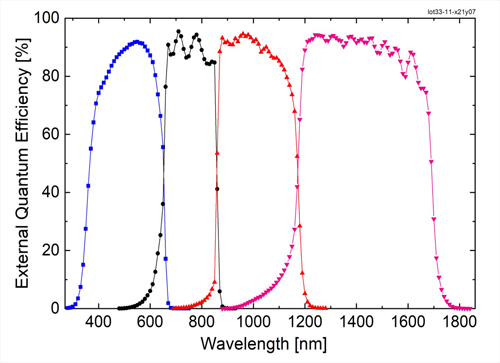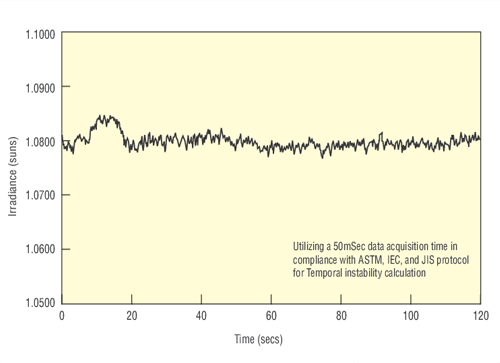 |
China Sales and Service Office: Contact: Alan Cao (曹全喜) Tel: +86-131 2475 3246 Email: cquanxi@163.com |
| Home | QE / IPCE / SR Measurements | I-V Measurements | I-V System Health | Services | About |
QEX10 Solar Cell Quantum Efficiency / IPCE / Spectral Response Measurement System Configure the QEX10 Quantum Efficiency / Spectral Response (SR)/ Incident Photon to Current Conversion Efficiency (IPCE) Measurement System to exactly match your research needs. Options include ♦ LED bias lights ♦ Discrete, variable slit and beam size ♦ Reflectance and Internal Quantum Efficiency Measurements ♦ I-V Measurements Get precision quantum efficiency measurements of a wide variety of solar cells the day of delivery with PV Measurements' turn-key Quantum Efficiency systems. ♦ System of choice by standards laboratories ♦ Mature product - over 300 QE systems in the field ♦ Built-in light bias and voltage bias ♦ Light bias capability up to 150 mA ♦ DC mode measurement capability (optional) ♦ Measures reflectance and IQE/APCE (optional) ♦ ASTM Method E 1021-06 compliant Multi - Junction Quantum Efficiency Measurements The QEX10 includes a broad spectrum white bias light that can be used to bias most devices and provide almost any desired bias spectrum with the correct filtering. Using two or three bias lights, it is easier to get the correct bias light level for each junction. The correct bias lighting along with the correct voltage bias can allows the discerning scientist to make accurate measurements of each of the individual junctions in a multi-junction measurements. High repeatability The basic solar cell quantum efficiency measurement system wavelength range is 300 to 1100 nm. Repeatability is better than ±0.3 % in the 400-1000 nm range and better than ±0.6 % in the 300-400 nm and 1000-1100 nm ranges for p-n junction solar cells. The probe beam spectral bandwidth is approximately 5 nm (narrower or wider bandwidth can be obtained by adjusting the monochromator slits). The measurement interval is selectable and is set to 10 nm as a default. The graph on the left shows the relative difference between 5 measurements done on a single crystal Si sample and the average of those measurements. ReferencesThe QEX10 has been in use at laboratories worldwide since 2010. Here is a selection of published papers in which the QEX10 Solar Cell Quantum Efficiency Measurement was used.System ConfigurationThe QEX10 Solar Cell Quantum Efficiency / IPCE / Spectral Response Measurement System has a variety of large variety of options and accessories. The table below gives an overview of many of the available options at a glance. Please select your type of device below to see which options we consider necessary for good measurements and which additional options we consider useful for your devices. Our measurements specialists can help you configure the system that is best for your research. The lines of the table are various options and the columns are types of test devices.Options and Accessories♦ 300 nm to 1400 nm spectral range♦ 300 nm to 1800 nm spectral range ♦ Reflectance and IQE measurement capability or SIQE ♦ 1.3 Hz to 50 Hz chopping speed ♦ DC mode measurement capability ♦ Quick – swap filter assembly ♦ LED bias lights ♦ Dual white bias lights ♦ Triple white bias lights ♦ Beam-up operation ♦ Setup and training at customer’s site ♦ Glove box interface ♦ Clamp test fixture ♦ Vacuum test fixture ♦ Test fixture temperature control ♦ X – Y scanning for response mapping at any wavelength (coarse LBIC) ♦ Custom test fixture Measure the response of any solar cellMeasure the quantum efficiency of any type of solar cell, including:♦ Mono crystalline silicon solar cell (Si) ♦ Multi crystalline silicon solar cell (mc-Si) ♦ Amorphous silicon solar cell (a-Si) ♦ Gallium arsenide solar cell (GaAs) ♦ Gallium indium arsenide solar cell (GaInAs) ♦ Gallium aluminum arsenide solar cell (GaAlAs) ♦ Gallium indium phosphite solar cell (GaInP) ♦ Cadmium telluride solar cell (CdTe) ♦ Indium phosphite solar cell (InP) ♦ Zinc oxide solar cell (ZnO) ♦ Copper indium selenide solar cell (CIS) ♦ Copper indium gallium selenide solar cell (CIGS) ♦ Dye sensitized solar cells (DSSC) or DSC Dye sensitized cells ♦ Inorganic solar cells ♦ Organic solar cells ♦ Polymer solar cells ♦ Single junction solar cells ♦ Multi junction solar cells ♦ Substrate solar cells ♦ Superstrate solar cells Individual systems may vary in appearance,components, and features. |
| Call +86-131 2475 3246 or email cquanxi@163.com to discuss your photovoltaic characterization needs. | Request Quote |